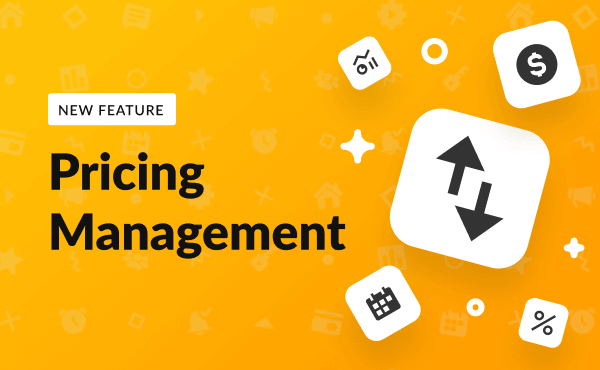12 Steps To A Profitable Airbnb Pricing Strategy

Airbnb pricing is one of the key components to ensuring that your short-term rental property is fulfilling its potential. However, when it comes to pricing optimization, the truth is that it requires a lot of forethought and consideration.
With more than 6 million listings in more than 220 countries, Airbnb has been a major industry disruptor since it started in 2007. For the last few years, hotels have been losing approximately $450 million every single year in direct revenues to Airbnb. With Airbnb’s exponential growth, it’s clear that establishing a sound pricing strategy is vital to make the most of the platform.
In this article, you will find a few comprehensive pricing strategies, along with their pros and cons. But first, it is important to learn what key points you need to think about to come up with your pricing. Below are some major points for you to note.
[lwptoc depth=”1″ hierarchical=”0″ numeration=”none” title=”” toggle=”0″ smoothScrollOffset=”30″ width=”600px” titleFontSize=”120%” titleFontWeight=”extrabold” itemsFontSize=”120%” colorScheme=”inherit”]
1. Consider Your Property Location
The first point to take into account when determining your pricing is the location of your property. It’s also crucial to research how your location will influence demand for your Airbnb and therefore, the overall viability of your short term rental business.
Ask yourself whether the area where your property is located has unique features, like tourist attractions or theme parks, that could drive demand all through the year. If this is the case, you will be able to set your prices at their maximum for a large part of the year.
On the other hand, if your city is home to big festivals or events that only happen at certain times during specific seasons, your demand will fluctuate as the seasons change. Therefore, you may need to change your pricing along with the change in season.
Other price influencers that you shouldn’t forget about are local rules and regulations or any travel restrictions to and from your location.
2. Take Into Account Your Property Type and Amenities
When deciding on the pricing, consider the amenities that you provide. If you are going beyond the basics, then your property deserves higher nightly prices. Great amenities such as a swimming pool, hot tub, or breathtaking views can significantly bump up your pricing.
Another major influencer on price is your property type. Larger and more opulent properties will appeal to travelers who are willing to spend more money for the extravagance and, because of this, these properties can attract a higher price point.
Meanwhile, smaller properties and shared spaces will need to be priced lower to remain competitive with other types of properties that offer the same thing.
3. Choose Your Target Guest
The type of audience your property will appeal to will be important when deciding on your pricing.
If your listing is offering luxury accommodation meant to attract travelers with deep pockets, your Airbnb should be priced at the maximum rate to reflect that you are providing a luxurious vacation.
Similarly, if your property will appeal to travelers like students or backpackers who are looking for more affordable accommodation, your nightly rate will need to reflect the budget-friendly prices they are looking for.
Then, you will also need to consider which sub-groups of travelers your property could be catering to. These could be families with kids, couples and honeymooners, Gen Z travelers, or businesspeople.
Each of these groups of travelers will have different expectations. Tailoring your Airbnb to accommodate these expectations can give you a better idea of how your nightly prices might change, depending on the type of guest you will choose to target.
4. Estimate Your Expenses
The goal of any Airbnb business is to generate a profit. This means that while it is necessary to price your Airbnb to beat the competition, your price settings need to outweigh the expenses of running it.

Before deciding on your pricing, calculate all the expenses you can expect while managing your rental, and then make sure your nightly rate is high enough to cover your expenses, like your raw materials and cleaning fee, and bring in revenue.
Some of the expenses you’ll need to add to your calculations are service fees, cleaning expenses to keep your home pristine, repair and maintenance costs, and restocking of supplies.
5. Research Your Competitors
Consider this: every traveler that looks at your Airbnb and thinks about making a booking is considering the exact same thing for a handful of other properties similar to yours.
In order to win over their bookings, your Airbnb needs to offer more value than the competition. To do this, you’ll need to know what your competition currently offers. Conducting a competitor analysis before setting your pricing will enable you to remain competitive among listings similar to yours.
Search for similar properties in your area and analyze how they compare to your rental in terms of:
- Property size
- Location
- Amenities
- Reviews
- Cancellation policies.
Then, identify your advantages and unique features and try to capitalize on them.
If your listing is completely new, it’s wise to have slightly lower prices than your competitors to incentivize travelers to book with you and get your first positive reviews. Once you’re more established, make sure to increase your pricing but don’t go overboard by charging way higher prices than your competitors, as this may scare off your potential bookers.
6. Be in Line with Your Business Goals and Objectives
Setting goals and objectives as part of a well-structured business plan can ensure that your Airbnb business goes the distance and experiences both short-term and long-term growth.
It is important to keep these goals in mind when making decisions and planning your Airbnb pricing.
For example, if you have set a goal for how much profit you would want to generate each month, your pricing needs to be set at the amount necessary to reach that goal — while still accounting for your expenses and occupancy goals.
Or if you have established an objective to host a certain number of people in your place each quarter, your prices need to remain competitive and attractive to travelers so that you can win more bookings.
7. Use Analytics to Set the Pricing Right
With all the different variables to consider, Airbnb pricing can get quite complicated for any host. Luckily, there are smart tools available to help you simplify the process.
Analytics software like AirDNA, AllTheRooms, and Transparent keep you informed about the short-term rental industry’s trends and developments. They provide access to market data, insights that you can use to determine your pricing and assist in creating a viable pricing strategy.
8. Understand the Platform
As a host, it is vital for you to be familiar with the Airbnb platform to ensure you understand its capabilities and are getting the most out of it.
When it comes to setting your prices on Airbnb, every host needs to understand the basics, like how to set a nightly rate. Here is how to do so in 4 easy steps:
- Go to Your listings select the listing you would like to add your prices to
- Click Pricing at the top of the page
- Click Edit, next to Nightly price
- Enter your desired nightly prices and click Save.
Airbnb goes a step further and offers a few tools to help you decide on your prices.
The first helpful addition is that Airbnb takes your listing into consideration to suggest a base price. However, in many cases, hosts have found these suggestions to be unsuitable.
The Airbnb Smart Pricing tool is another option designed to automate your pricing based on demand and supply, property type and amenities, local events, reviews, and other data relevant to your listing. However, some hosts have claimed that the prices suggested by the tool are usually lower than they believe their listing is valued.
Another aspect of Airbnb pricing that you should be fully aware of is Airbnb’s service fee structure. When deciding on your prices, it’s important to remember to factor in the host fees too.
9. Consider 5 Major Components of Airbnb Pricing Strategies

There are 5 major components to consider when deciding on your Airbnb pricing strategy. These components can fluctuate your prices up or down depending on which decision you make.
The components include the:
1. Nightly Rate
Your nightly rate is the base price you charge per night for your guests to stay at your house or apartment. These prices can also change depending on if you want to charge per guest or rent the entire place for one nightly rate up to a maximum number of guests.
2. Cleaning Fees
An Airbnb cleaning fee is a one-time fee that you can charge guests for the cleaning of the property after their stay. It is not compulsory to charge this fee, however, most Airbnb owners decide to do so to cover the costs of cleaning after each guest turnover.
3. Security Deposit
A security deposit acts as a safety net in case your guest’s damage or break anything in your Airbnb during their stay.
This amount is stated separately and is refundable if the guests do not cause any damage to your property. On the other hand, when minor damage like breaking a glass or vase eventually happens, you will be able to use the security deposit to make the repairs instead of paying out of pocket.
4. Extra Charges
Each host will need to decide whether or not to charge extra for additional services and extra guests.
It makes sense for you to charge extra for additional services like daily housekeeping, guided tours or offering prepared meals and picnic baskets. These provide additional value to the guest’s stay and come at an extra cost to the host. Also, every guest may not want these additional services, so it is a good idea not to force them to pay for services they may not want.
Deciding whether or not to charge for extra guests may take a bit more thought. First, you’ll need to decide whether you allow extra guests at all. Extra guests come with extra expenses like using more utilities and supplies. You will need to decide whether you are okay with your guests inviting a friend to visit, and if you are, what extra fee you would want to charge to compensate for the extra costs.
5. Discounts
If you would like to boost the number of bookings you get during a specific time like slower seasons, you could always offer special discounts on your usual rate. This is a temporary reduction in your nightly rate to entice more travelers to book a stay. Airbnb allows you to run special offers and promotions straight from the platform.
10. Optimize Your Revenue All Year Round with Vacation Rental Software
Regardless of the pricing strategy you choose, you should keep all the aspects of managing your vacation rental under control to ensure its continuous growth.
Vacation rental software such as iGMS helps to reduce costs, ensures streamlined management of your short-term rentals without a big team in place, and provides all the tools you need to optimize occupancy and maximize revenue all year round.
Some of the top iGMS features include:
- Managing multiple accounts and listings on the top vacation rental platforms from a single interface
- Triggered automated messaging and a unified inbox to organize your messages into a single feed and ensure prompt replies
- Sharing daily cleaning schedules with your cleaners and auto-assigning cleaning tasks
- Adjusting your pricing in a dynamic way through smart pricing integrations with PriceLabs, DPGO, and Wheelhouse
- Receiving payouts and creating invoices by connecting your Stripe profile to iGMS
- Creating your own direct booking website using a direct booking toolkit
- Creating essential reports within minutes and tracking key metrics with our Dashboard feature.
11. Adopt the Airbnb Pricing Strategy That Suits Your Business Goals
Now it’s time to decide on a pricing strategy that can guide you when setting your nightly rates. The strategy you decide on will need to meet your own goals and objectives so that it can help your business grow.
Here are a few different Airbnb pricing strategies to consider so that you can get your pricing optimization on the right track:
Maximum Fill-Rate Strategy
This Airbnb pricing strategy entails that you do your best to be competitive when it comes to pricing. In order to do so, you have to provide at least the same value as your competitors. In other words, you want to squeeze out the absolute maximum in terms of filling your rentals.
Pros:
- It guarantees that you will have a high occupancy rate.
- It will ensure a stable income.
Cons:
- It requires a lot of hard work, dedication, and serious attention.
- Your nightly prices are going to be lower than the market average.
Example: This is best used when you have a gap period of a few nights. Your average price could be $100 per night but to get the gap period filled quickly, you will lower the price to $15.
Who is this good for?
- Individual hosts.
- Airbnb hosts who are capable of fully focusing on managing their Airbnb.
- Vacation rental management companies.
Maximum Rate Per Night Strategy
This is another known Airbnb pricing strategy that comes with its pros and cons. It is going to require you to set visibly higher nightly rates to increase the overall net profit from a single booking.
Pros:
- You spend a lot less time managing your Airbnb.
- Fewer bookings mean that you would have fewer problems to deal with.
- You are making a good profit even if you have a fill rate of less than 50%.
Cons:
- Lower fill rate.
- The home needs to be absolutely unique.
Example: This is best if you own an exquisite apartment in a very attractive destination. You can afford to bump up the price a lot more than the average to attract only wealthy travelers.
Who is it good for?
- Premium-class property owners.
- Unique vacation rentals.
Long-Term Rentals Strategy
This predominantly relies on the premise that you would be able to host your rental for a longer period of time. You will be renting out at monthly rates and dealing with the same customer for a longer period. There are serious advantages and some cons as well.
Pros:
- This pricing strategy will lower the effort it takes to manage your listing.
- It is also going to lower the risk when it comes to highly regulated and in-demand locations.
Cons:
- The listing needs to be exposed on platforms other than Airbnb as well.
- This type of renting strategy also generates less profit.
- You will have to sign a rental agreement which is an additional burden.
- There will likely be showings before the accommodation is going to be rented out.
Example: This is a good strategy if you are the owner of a great apartment in NYC but you need to move out for the next 2 years due to work engagements. You don’t want to sell your property but you want to generate some profit. Long-term renting is the most obvious and convenient option in this regard.
Who is it good for?
- It is suitable for investment properties that are located in areas that are highly regulated.
- Hosts who are out of the country.
- Traditional property managers.

Balanced Airbnb Management
This particular approach targets the earning of maximum revenue by using all of the aforementioned strategies. This is going to provide you with a maximized profit as well as an increased fill rate.
Pros:
- A higher fill rate for your listing.
- It’s the best way to earn a lot of money on Airbnb.
Cons:
- It will make you a lot more involved with other people.
- It is absolutely time-consuming.
Example: This could be a beneficial strategy if you are a property owner and you want to enhance your earnings. This is where you want to focus on signing long-term deals in advance to make sure that you have no gaps. However, as soon as the hit period starts, you can switch to a maximum rate or the maximum fill-in strategy to increase your earnings.
Who is it good for?
- Larger businesses that have a team.
- Hosts who are absolutely devoted to running their Airbnb.
12. Automate Pricing with Dynamic Pricing Tools
If you are indecisive about which pricing strategy fits your property best, or you want to free up more time to focus on other parts of managing your Airbnb, there is always the option to automate your pricing with dynamic pricing software.
Dynamic pricing tools are able to automatically change your nightly rates in real time based on current fluctuations in the market. These fluctuations could be changes in demand and supply, changes in season, competitor occupancy, and competitor pricing.
Most of the tools on the market today also have AI capabilities which means they can not only automate and optimize, but design your dynamic pricing strategy too. There is a free option, called Airbnb Smart Pricing, but it has received mixed reviews. Some hosts claim that it does not do much for hosts and instead prices listings with a focus on boosting the overall Airbnb business.
The more advanced tools do more than just set different nightly rates for your high and low seasons. They use market data and AI technology to adjust your prices in response to the slightest changes in the price-influencing factors, saving you the stress of having to constantly analyze your prices manually.
There are a number of leading dynamic pricing options available for you to take advantage of, over and above Airbnb Smart Pricing. Some of them include Pricelabs, Wheelhouse, and DPGO. All of these tools are also able to integrate with iGMS, allowing you to conveniently manage your pricing on the same interface as all your other hosting tasks.
About the Author
Callan Riddles is the Content and Social Media Specialist at iGMS. Callan has a passion for finding new ways to help vacation rental businesses thrive. In her free time, she loves to travel, read, and experience all the new things that life has to offer.








![Your Monthly iGMS Roundup [February 2020]](/content/images/size/w600/wordpress/2020/02/igms-roundup-feb-2020-cover.png)

